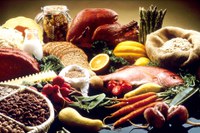Prairie Fare: Are You Getting Your Omega-3 Fats?
(Click an image below to view a high-resolution image that can be downloaded)
“How many servings of seafood and fish did you eat during the past week?”
The presenter posed this question to attendees.
Unfortunately, I was not meeting the goal.
Would you meet the goal of two servings of fish or seafood a week? That’s about eight ounces weekly.
The palm of an average adult’s hand is the visual representation of a “serving” for fish or seafood.
I put fish on my home menu that day to join our usual mix of meat, poultry, beans, nuts and seeds as protein sources.
Fresh, canned and frozen fish and seafood all count toward the goal. Canned and frozen fish usually offer money savings too.
Why do nutrition experts recommend eating more fish and seafood? This high-protein food is somewhat unique compared with other foods in its significant content of omega-3 fats.
Let’s stroll back to biology or chemistry class for a minute. “Omega-3” refers to the placement of the double bond in the long chain of carbon atoms that make up fats. “Omega” means “the end.” Omega-3 means the double bond in the carbon chain is third from the end of the chain.
You might see EPA, DHA or ALA on supplements or in some cases, on baby formula containers. We find EPA (eicosapentaenoic acid) and DHA (docosahexaenoic acid) naturally in fish and seafood. ALA (alpha-linolenic acid) refers to the omega-3 fats in plants.
Usually labels list the abbreviation instead of the tongue-twister scientific names, fortunately for us. You can impress your friends with these details.
Infant formula is supplemented with DHA because of its role in brain and eye development during infancy. Breast milk naturally contains this fatty acid, but the mom’s diet also determines the amount of DHA in the milk produced.
For adults, adequate amounts of omega-3 fats in our diet can help prevent heart disease.
In fact, research has shown that these powerful fats can reduce risk of blood clots and help prevent sudden cardiac death among those with abnormal heart rhythms. It also helps keep our arteries free from damaging plaque deposits. In some cases, more omega-3 fats may reduce your triglyceride levels.
Other researchers have shown that eating more foods high in omega-3 fats may increase our HDL “good” cholesterol levels and even lower our blood pressure.
However, don’t throw out any heart-related prescriptions you might be taking. Talk with your healthcare provider or dietitian about changes in your diet. If you are thinking about a fish oil supplement, visit with your healthcare provider about safe amounts before you begin.
Pregnant or nursing women also should visit with their healthcare provider about fish and seafood consumption. They should avoid eating swordfish, tilefish and king mackerel due to higher levels of mercury. However, canned fish and smaller fish are healthful options.
Some of the best sources of omega-3 fats are mackerel, salmon (especially wild caught), oysters, herring, sardines, lake trout, tuna (albacore), freshwater white fish, halibut and striped bass.
Get a little creative with fish choices. Try fish tacos, grilled or baked fish on a salad or salmon patties. Yes, the Midwestern staple, “Tuna Noodle Hotdish” counts.
Have a tuna salad sandwich for lunch. Maybe you like sardines or herring. Yes, these foods count toward the recommendation too. Enjoy them with whole-grain crackers for a snack.
What if you do not like fish or seafood or cannot eat them because you have allergies? Some plant foods also provide omega-3 fats. Chia seeds, Brussels sprouts, hemp seeds, walnuts and flaxseeds all provide omega-3 fats.
Foods such as eggs may contain omega-3s depending on the chicken’s feed. Grass-fed animals produce milk and meat higher in omega-3 fats.
Bottom line, enjoy a wide range of foods from all the food groups, and consider adding some fish, seafood or other sources of omega-3 fats to your diet.
This week’s recipe and nutrition analysis is courtesy of the Iowa State University’s Spend Smart. Eat Smart. program. Baking instead of deep frying reduces calories and fat.
Baked Fish and Chips
Chip ingredients:
4 cups potatoes (4 medium, unpeeled)
1 tablespoon oil (canola or vegetable)
1/8 teaspoon salt
1/8 teaspoon ground black pepper
Fish ingredients:
4 fish fillets, thawed (salmon or other fish, about 3 oz. each)
3 cups cornflakes
1 egg
2 tablespoons water
1/3 cup flour
Note that the potatoes take longer to cook, so prepare potatoes/chips first. While potatoes are baking, prepare fish.
Chip directions: Preheat oven to 425 F. Scrub potatoes under running water using a clean vegetable brush. Cut in half and then into 1/4-inch slices. Combine potatoes, oil, salt and pepper in a bowl. Stir so potatoes are coated with oil. Spray a cookie sheet with cooking spray and lay slices out in a single layer. Bake for 15 minutes. Turn potatoes over and bake for 15 minutes more (for a total of 30 minutes)
Fish directions: Cut each fillet into two strips. Place cornflakes in a plastic zip-close bag. Crush by rolling a glass, can or rolling pin over the bag. Beat egg and water together in a bowl. Spray a cookie sheet with cooking oil spray. Put flour in a dish. Dip each strip into flour, then egg mixture, then cornflakes. Place fish on the sheet and bake in oven for 15 minutes until fish reaches an internal temperature of 145 F or flakes easily with a fork.
Makes four servings. Each serving (two fish strips and one cup potatoes) has 410 calories, 7 grams (g) fat, 26 g protein, 63 g carbohydrate, 6 g fiber and 300 milligrams sodium.
(Julie Garden-Robinson, Ph.D., R.D., L.R.D., is a North Dakota State University Extension food and nutrition specialist and professor in the Department of Health, Nutrition and Exercise Sciences. Follow her on Twitter @jgardenrobinson)
NDSU Agriculture Communication – Nov. 10, 2021
Source: Julie Garden-Robinson, 701-231-7187, julie.garden-robinson@ndsu.edu
Editor: Elizabeth Cronin, 701-231-5391, elizabeth.cronin@ndsu.edu




